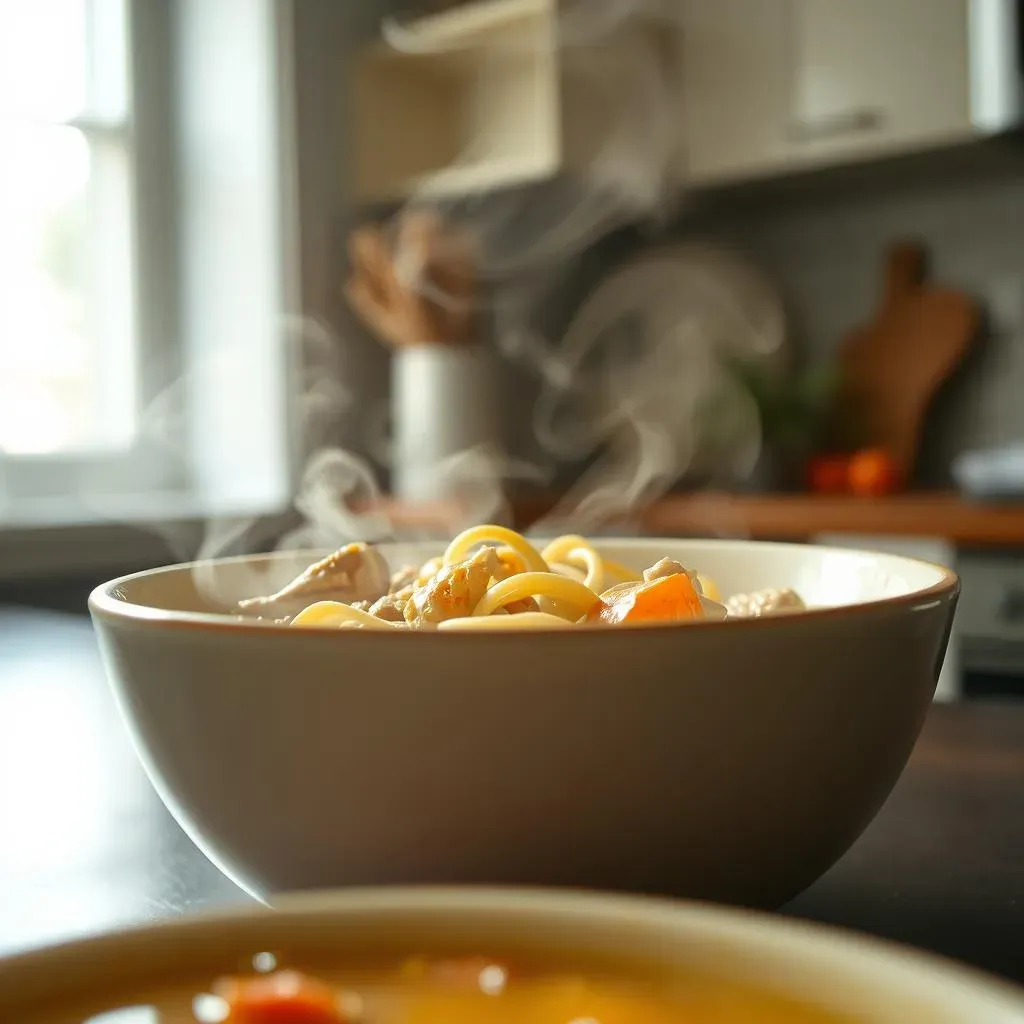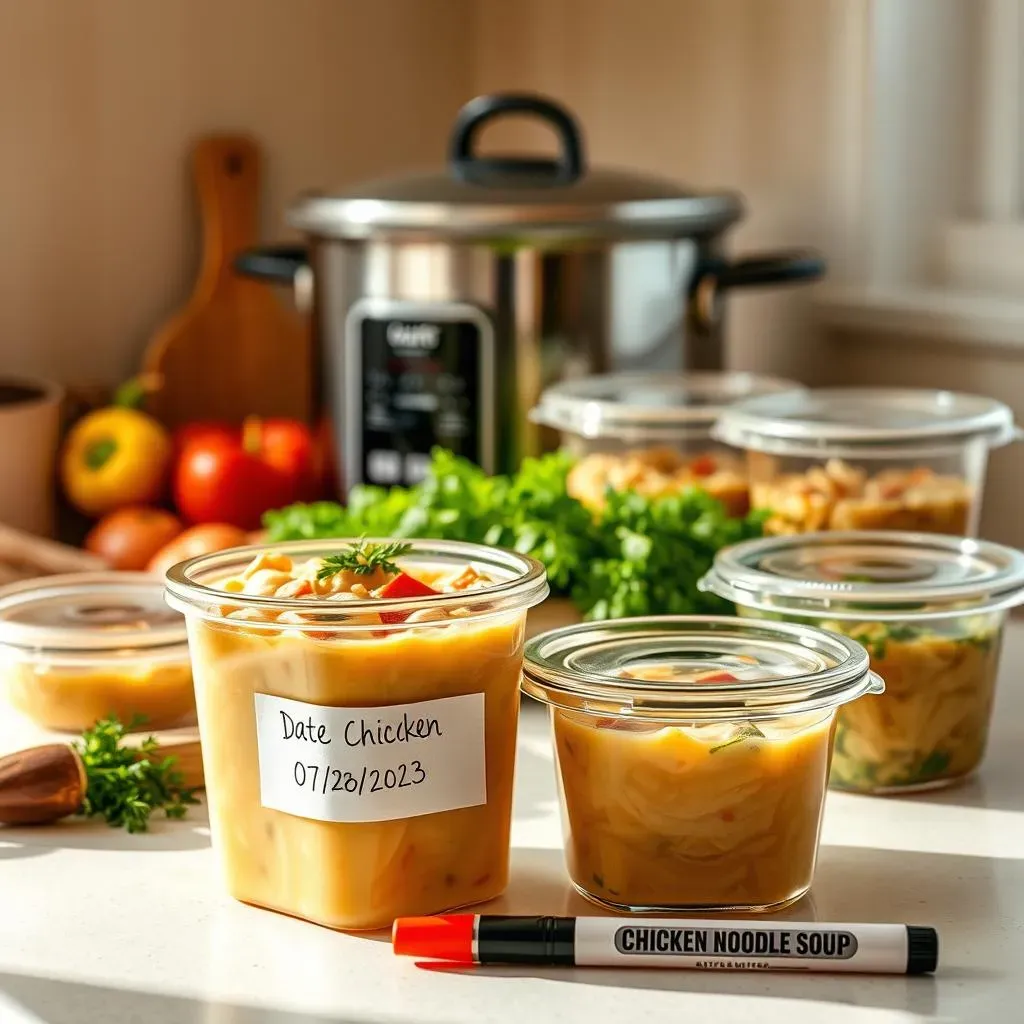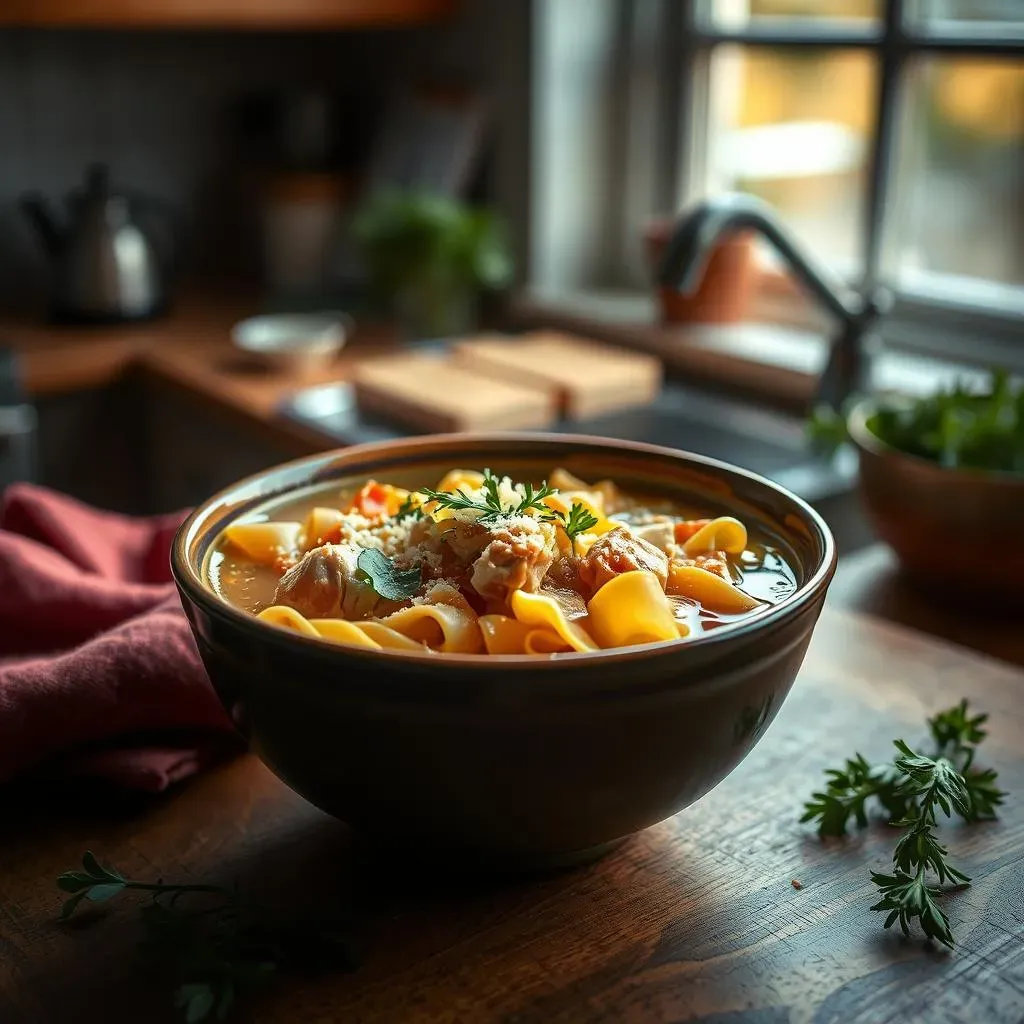Table of Contents
Picture this: you've just finished a big bowl of comforting chicken noodle soup, the kind that warms you from the inside out. But what about the leftovers? That delicious, golden broth and tender noodles are calling your name, but you're not sure how long they'll stay safe to eat. If you've ever wondered, "how long does chicken noodle soup last in the fridge?" you're definitely not alone. This article will be your guide, we will discuss the typical shelf life of homemade soup, what can make it spoil faster, and how to spot the signs that it's time to toss it. We'll also cover some easy tips to help you store your soup correctly, so you can enjoy it for as long as possible without any tummy troubles. So, grab a spoon, and let's dive in to keep that soup safe and yummy!
The Fridge Life of Homemade Chicken Noodle Soup: What to Expect

The Fridge Life of Homemade Chicken Noodle Soup: What to Expect
Okay, so you've made a killer batch of chicken noodle soup, and now you're wondering how long that liquid gold will last in the fridge. Generally speaking, homemade chicken noodle soup is good for about 3 to 4 days when stored properly. That's the sweet spot. Think of it like a ticking clock, the sooner you eat it, the better the quality and taste will be. After that, things can start to get a little dicey in terms of flavor and food safety. It's not like a fine wine that gets better with time; it's more like a delicate flower that needs to be enjoyed while it's fresh. But, keep in mind, this isn't a hard and fast rule, and there are a few things that can affect how long your soup stays safe and delicious.
Factors Affecting How Long Chicken Noodle Soup Lasts

Factors Affecting How Long Chicken Noodle Soup Lasts
The Ingredients You Use
What goes into your soup plays a huge role in how long it stays fresh. For instance, if you used fresh veggies, they might not last as long as frozen ones. Fresh herbs can also be a bit more delicate, and they might start to turn sooner than you'd expect. The type of chicken matters too. If you cooked it directly in the soup, it will have a different lifespan than pre-cooked chicken added later. Even the noodles can make a difference; some get mushy quicker than others, which can affect the overall texture and how long it tastes good. It's kind of like a science experiment in your fridge.
And don't forget about any dairy you might add. A splash of cream or milk can make the soup extra comforting but will also shorten its lifespan, as dairy is known to spoil faster. So, while a creamy chicken noodle might hit the spot, you'll need to keep a closer eye on it and enjoy it sooner rather than later. It is important to think about each ingredient when you are thinking about storing your soup.
How You Store It
Storage is key to keeping your chicken noodle soup fresh. Think of your fridge as a mini-ecosystem where things can go south fast if not handled properly. The temperature of your fridge is crucial; it should be at or below 40°F (4°C). If it's warmer than that, bacteria can have a field day, and that's not what we want. Always put your soup in an airtight container as soon as it has cooled down; leaving it out on the counter too long is a big no-no.
Also, how you store the soup matters. A shallow container will help the soup cool down faster, which is important for safety. Deep containers can take a long time to cool, and the center might stay warm for too long, creating a breeding ground for bacteria. Think of it like packing a lunchbox; you want to keep things safe and fresh, not create a science experiment that's brewing in the dark.
Ingredient | Impact on Shelf Life |
|---|---|
Fresh Veggies | May shorten shelf life |
Frozen Veggies | Usually last longer |
Fresh Herbs | Can spoil faster |
Cooked Chicken | Last longer than pre-cooked |
Dairy | Significantly shortens shelf life |
Signs Your Chicken Noodle Soup Has Gone Bad

Signs Your Chicken Noodle Soup Has Gone Bad
The Smell Test
Okay, so your soup has been chilling in the fridge for a few days, and you're wondering if it's still good to go. The first thing you should do is give it a good sniff. Your nose is a surprisingly good indicator of whether something is off. Fresh chicken noodle soup should have a pleasant, savory aroma. If it smells sour, funky, or just plain weird, that's a big red flag. Trust your gut – or rather, your nose – if something smells wrong, it probably is. It is important to remember that smell is your best friend when checking food.
Sometimes, the change in smell can be subtle, especially if you're not used to sniffing out spoiled food. It might not be an overpowering stink, but more of a faint, slightly off odor. Don't ignore these subtle cues. It's better to be safe than sorry, especially when it comes to foodborne illnesses. Remember, it is better to throw away a small portion of soup than getting a stomach ache.
The Visual Clues
Next up, give your soup a good look. Sometimes, the signs of spoilage are pretty obvious. If you see mold growing on the surface, that's a clear signal that your soup has gone bad and it's time to toss it. Even if you only see a little bit of mold, it's best to discard the whole batch, as the mold can spread its roots throughout the liquid.
Another thing to look for is a change in texture or appearance. If the soup looks slimy, cloudy, or the broth has thickened to an unnatural consistency, those are signs that bacteria have been having a party in your container. Also, look at the vegetables and noodles. If they've become mushy or discolored, it's a pretty good indication that your soup has seen better days. The look of your soup can tell you a lot about its current state.
Remember that it is not worth to risk your health with a soup that looks suspicious.
Sign | What to Do |
|---|---|
Sour or Off Smell | Discard the soup |
Visible Mold | Discard the soup |
Slimy Texture | Discard the soup |
Cloudy Broth | Discard the soup |
Mushy Vegetables or Noodles | Discard the soup |
When in Doubt, Throw It Out
If you're still not sure about your soup, it's always better to err on the side of caution. Food poisoning is no fun, and it's not worth the risk to try and salvage a questionable batch of soup. If you have any doubts at all, just throw it away. It's a good practice to label your soup with the date you made it, so you can keep track of how long it's been in the fridge. This helps you avoid playing the "is it still good?" guessing game.
Think of it like this: your health is more important than a bowl of soup. It's better to be safe and toss it than risk getting sick. There's always more soup to be made, and now you're an expert on how to keep it fresh and safe. Remember, when in doubt, throw it out.
Tips for Storing Chicken Noodle Soup to Maximize Fridge Life

Tips for Storing Chicken Noodle Soup to Maximize Fridge Life
Cool it Down Quickly
Alright, so you've got a pot of delicious chicken noodle soup, and you're ready to stash it in the fridge. But hold up, not so fast! The first rule of soup storage is to cool it down quickly. Don't just pop that hot pot straight into the refrigerator. That'll raise the fridge's temperature and create a warm zone where bacteria can thrive. Instead, let your soup cool down at room temperature first, but don't leave it out for more than two hours.
Once it's cooled a bit, transfer it to shallow containers. The shallower the container, the faster the soup will cool, which is essential for food safety. Think of it like this, a shallow pool cools faster than a deep lake. You can even use a water bath to speed up the cooling process. Just place your container in a sink filled with cold water, and stir the soup occasionally. This will help bring the temperature down quickly and safely. Remember, the goal is to get it cold fast, so those pesky bacteria don't get a chance to grow.
Airtight Containers are Your Friend
Now that your soup is cooled, it's time to get serious about storage. Airtight containers are your best friend here. They'll protect your soup from picking up weird odors from other items in your fridge, and they’ll also prevent it from drying out. Nobody likes dried-out soup, it's just not as satisfying. Make sure your containers are clean and dry before adding the soup.
Consider using glass containers, because they're great for food storage as they don't absorb odors and they are easy to clean, and they allow you to see what is inside, which can help you keep a tab on the state of the soup. Plastic containers are also an option, but make sure they are food-grade and BPA-free. Regardless of what you choose, the key is that the container seals tightly to keep your soup fresh and safe.
Tip | Why It Matters |
|---|---|
Cool Quickly | Prevents bacteria growth |
Use Shallow Containers | Speeds up cooling process |
Airtight Containers | Keeps soup fresh and prevents odors |
Clean Containers | Prevents contamination |
Label and Date
Finally, a little pro tip that can save you from food safety roulette: label and date your soup. It's easy to forget when you made something, especially if you've got a busy week and a fridge full of leftovers. Grab a marker and write the date on the container before you put it in the fridge. This will help you keep track of how long it's been in there, and it will prevent any guesswork.
If you want to take it a step further, add the name of the soup, especially if you have multiple containers of different soups. This way, you won't have to open each container to see what's inside. This simple step can make a big difference in preventing food waste and ensuring that you're always eating safe, fresh food. It's like giving your soup a little ID tag so you know exactly who it is and how old it is.
